Genetic and Phytopathogenic Characterization of Endemic Colletotrichum Isolates in Major Olive Cultivars of Greece
Abstract
1. Introduction
2. Materials and Methods
2.1. Selection of Experimental Olives Groves and Plant Material
2.2. Isolation of Colletotrichum spp. from Olive Drupes
2.3. DNA Extraction of Colletotrichum spp. Isolates
2.4. Genetic Characterization of Colletotrichum spp. Isolates
2.5. Analyses of Sequences and Species Identification
2.6. Ex Vivo Virulence Evaluation
2.7. Statistical Analysis
3. Results
3.1. Morphology and Geographical Distribution of Colletotrichum Isolates
3.2. Phylogenetic Analysis
3.3. The Pathogenicity of Ex Vivo Colletotrichum spp. Isolates
4. Discussion
Supplementary Materials
Author Contributions
Funding
Data Availability Statement
Conflicts of Interest
References
- Aydin, M.; Tombuloglu, H.; Hernandez, P.; Dorado, G.; Unver, T. Olive-Tree Genome Sequencing: Towards a Better Understanding of Oil Biosynthesis. In Oil Crop Genomics; Tombuloglu, H., Unver, T., Tombuloglu, G., Hakeem, K.R., Eds.; Springer International Publishing: Cham, Switaerland, 2021; pp. 75–87. [Google Scholar]
- ELSTAT. Agricultural Producrtion in Greece. 2021. Available online: https://www.statistics.gr/en/statistics/-/publication/SPG06 (accessed on 6 August 2024).
- Talhinhas, P.; Loureiro, A.; Oliveira, H. Olive anthracnose: A yield- and oil quality-degrading disease caused by several species of Colletotrichum that differ in virulence, host preference and geographical distribution. Mol. Plant Pathol. 2018, 19, 1797–1807. [Google Scholar] [CrossRef]
- Cacciola, S.O.; Faedda, R.; Sinatra, F.; Agosteo, G.E.; Schena, L.; Frisullo, S.; di San Lio, G.M. Olive anthracnose. J. Plant Pathol. 2012, 94, 29–44. [Google Scholar]
- Iliadi, M.K.; Tjamos, E.C.; Antoniou, P.P.; Tsitsigiannis, D.I. First Report of Colletotrichum acutatum Causing Anthracnose on Olives in Greece. Plant Dis. 2017, 102, 820. [Google Scholar] [CrossRef]
- Markakis, E.A.; Roditakis, E.N.; Kalantzakis, G.S.; Chatzaki, A.; Soultatos, S.K.; Stavrakaki, M.; Tavlaki, G.I.; Koubouris, G.C.; Bagkis, N.; Goumas, D.E. Characterization of Fungi Associated with Olive Fruit Rot and Olive Oil Degradation in Crete, Southern Greece. Plant Dis. 2021, 105, 3623–3635. [Google Scholar] [CrossRef] [PubMed]
- Riolo, M.; Pane, A.; Santilli, E.; Moricca, S.; Cacciola, S.O. Susceptibility of Italian olive cultivars to various Colletotrichum species associated with fruit anthracnose. Plant Pathol. 2023, 72, 255–267. [Google Scholar] [CrossRef]
- Kolainis, S.; Koletti, A.; Lykogianni, M.; Karamanou, D.; Gkizi, D.; Tjamos, S.E.; Paraskeuopoulos, A.; Aliferis, K.A. An integrated approach to improve plant protection against olive anthracnose caused by the Colletotrichum acutatum species complex. PLoS ONE 2020, 15, e0233916. [Google Scholar] [CrossRef] [PubMed]
- Moral, J.; Trapero, A. Assessing the Susceptibility of Olive Cultivars to Anthracnose Caused by Colletotrichum acutatum. Plant Dis. 2009, 93, 1028–1036. [Google Scholar] [CrossRef]
- Talhinhas, P.; Mota-Capitão, C.; Martins, S.; Ramos, A.P.; Neves-Martins, J.; Guerra-Guimarães, L.; Várzea, V.; Silva, M.C.; Sreenivasaprasad, S.; Oliveira, H. Epidemiology, histopathology and aetiology of olive anthracnose caused by Colletotrichum acutatum and C. gloeosporioides in Portugal. Plant Pathol. 2011, 60, 483–495. [Google Scholar] [CrossRef]
- Moral, J.; Bouhmidi, K.; Trapero, A. Influence of Fruit Maturity, Cultivar Susceptibility, and Inoculation Method on Infection of Olive Fruit by Colletotrichum acutatum. Plant Dis. 2008, 92, 1421–1426. [Google Scholar] [CrossRef] [PubMed]
- Leoni, C.; Bruzzone, J.; Villamil, J.J.; Martínez, C.; Montelongo, M.J.; Bentancur, O.; Conde-Innamorato, P. Percentage of anthracnose (Colletotrichum acutatum s.s.) acceptable in olives for the production of extra virgin olive oil. Crop Prot. 2018, 108, 47–53. [Google Scholar] [CrossRef]
- Moral, J.; Agustí-Brisach, C.; Raya, M.C.; Jurado-Bello, J.; López-Moral, A.; Roca, L.F.; Chattaoui, M.; Rhouma, A.; Nigro, F.; Sergeeva, V.; et al. Diversity of Colletotrichum Species Associated with Olive Anthracnose Worldwide. J. Fungi 2021, 7, 741. [Google Scholar] [CrossRef] [PubMed]
- Ferronato, B.; Ingold, A.; Moreira, V.; Bentancur, O.; Alaniz, S.; Mondino, P. Detection and quantification of Colletotrichum survival on olive tree (Olea europaea L.). Eur. J. Plant Pathol. 2023, 167, 77–87. [Google Scholar] [CrossRef]
- Chattaoui, M.; Raya, M.C.; Bouri, M.; Moral, J.; Perez-Rodriguez, M.; Trapero, A.; Msallem, M.; Rhouma, A. Characterization of a Colletotrichum population causing anthracnose disease on Olive in northern Tunisia. J. Appl. Microbiol. 2016, 120, 1368–1381. [Google Scholar] [CrossRef] [PubMed]
- Talhinhas, P.; Neves-Martins, J.; Oliveira, H.; Sreenivasaprasad, S. The distinctive population structure of Colletotrichum species associated with olive anthracnose in the Algarve region of Portugal reflects a host–pathogen diversity hot spot. FEMS Microbiol. Lett. 2009, 296, 31–38. [Google Scholar] [CrossRef] [PubMed]
- Romero, J.; Santa-Bárbara, A.E.; Moral, J.; Agustí-Brisach, C.; Roca, L.F.; Trapero, A. Effect of latent and symptomatic infections by Colletotrichum godetiae on oil quality. Eur. J. Plant Pathol. 2022, 163, 545–556. [Google Scholar] [CrossRef]
- Farr, D.F.; Aime, M.C.; Rossman, A.Y.; Palm, M.E. Species of Colletotrichum on Agavaceae. Mycol. Res. 2006, 110, 1395–1408. [Google Scholar] [CrossRef]
- Baroncelli, R.; Talhinhas, P.; Pensec, F.; Sukno, S.A.; Le Floch, G.; Thon, M.R. The Colletotrichum acutatum Species Complex as a Model System to Study Evolution and Host Specialization in Plant Pathogens. Front. Microbiol. 2017, 8, 2001. [Google Scholar] [CrossRef] [PubMed]
- Schena, L.; Abdelfattah, A.; Mosca, S.; Li Destri Nicosia, M.G.; Agosteo, G.E.; Cacciola, S.O. Quantitative detection of Colletotrichum godetiae and C. acutatum sensu stricto in the phyllosphere and carposphere of olive during four phenological phases. Eur. J. Plant Pathol. 2017, 149, 337–347. [Google Scholar] [CrossRef]
- Schena, L.; Mosca, S.; Cacciola, S.O.; Faedda, R.; Sanzani, S.M.; Agosteo, G.E.; Sergeeva, V.; Magnano di San Lio, G. Species of the Colletotrichum gloeosporioides and C. boninense complexes associated with olive anthracnose. Plant Pathol. 2014, 63, 437–446. [Google Scholar] [CrossRef]
- Talhinhas, P.; Gonçalves, E.; Sreenivasaprasad, S.; Oliveira, H. Virulence diversity of anthracnose pathogens (Colletotrichum acutatum and C. gloeosporioides species complexes) on eight olive cultivars commonly grown in Portugal. Eur. J. Plant Pathol. 2015, 142, 73–83. [Google Scholar] [CrossRef]
- Licciardello, G.; Moral, J.; Strano, M.C.; Caruso, P.; Sciara, M.; Bella, P.; Sorrentino, G.; Di Silvestro, S. Characterization of Colletotrichum strains associated with olive anthracnose in Sicily. Phytopathol. Mediterr. 2022, 61, 139–151. [Google Scholar] [CrossRef]
- Peres, F.; Talhinhas, P.; Afonso, H.; Alegre, H.; Oliveira, H.; Ferreira-Dias, S. Olive Oils from Fruits Infected with Different Anthracnose Pathogens Show Sensory Defects Earlier Than Chemical Degradation. Agronomy 2021, 11, 1041. [Google Scholar] [CrossRef]
- Kottaridi, K.; Milionis, A.; Demopoulos, V.; Nikolaidis, V.; Tsalgatidou, P.C.; Tsafouros, A.; Kotsiras, A.; Vithoulkas, A. Comparative analysis of machine learning classification algorithms for predicting olive anthracnose disease. J. Auton. Intell. 2024, 7, 1466. [Google Scholar] [CrossRef]
- Sun, J.; Guo, L.; Zang, W.; Ping, W.; Chi, D. Diversity and ecological distribution of endophytic fungi associated with medicinal plants. Sci. China Ser. C Life Sci. 2008, 51, 751–759. [Google Scholar] [CrossRef]
- Azevedo-Nogueira, F.; Gomes, S.; Carvalho, T.; Martins-Lopes, P. Development of high-throughput real-time PCR assays for the Colletotrichum acutatum detection on infected olive fruits and olive oils. Food Chem. 2020, 317, 126417. [Google Scholar] [CrossRef]
- Azevedo-Nogueira, F.; Gomes, S.; Lino, A.; Carvalho, T.; Martins-Lopes, P. Real-time PCR assay for Colletotrichum acutatum sensu stricto quantification in olive fruit samples. Food Chem. 2021, 339, 127858. [Google Scholar] [CrossRef]
- Garrido, C.; Carbú, M.; Fernández-Acero, F.J.; Boonham, N.; Colyer, A.; Cantoral, J.M.; Budge, G. Development of protocols for detection of Colletotrichum acutatum and monitoring of strawberry anthracnose using real-time PCR. Plant Pathol. 2009, 58, 43–51. [Google Scholar] [CrossRef]
- Kang, E.C.; Hassan, O.; Kim, K.-M.; Chang, T. Molecular Characterization and Fungicide Sensitivity of Jujube Pathogens Colletotrichum gloeosporioides Sensu Stricto and Colletotrichum nymphaeae in South Korea. Plant Dis. 2022, 107, 861–869. [Google Scholar] [CrossRef]
- Weir, B.S.; Johnston, P.R.; Damm, U. The Colletotrichum gloeosporioides species complex. Stud. Mycol. 2012, 73, 115–180. [Google Scholar] [CrossRef]
- Tsalgatidou, P.C.; Thomloudi, E.-E.; Baira, E.; Papadimitriou, K.; Skagia, A.; Venieraki, A.; Katinakis, P. Integrated Genomic and Metabolomic Analysis Illuminates Key Secreted Metabolites Produced by the Novel Endophyte Bacillus halotolerans Cal.l.30 Involved in Diverse Biological Control Activities. Microorganisms 2022, 10, 399. [Google Scholar] [CrossRef]
- Tang, D.; Chen, M.; Huang, X.; Zhang, G.; Zeng, L.; Zhang, G.; Wu, S.; Wang, Y. SRplot: A free online platform for data visualization and graphing. PLoS ONE 2023, 18, e0294236. [Google Scholar] [CrossRef] [PubMed]
- Sharma, G.; Maymon, M.; Meshram, V.; Freeman, S. Characterization of Colletotrichum Isolates from Strawberry and Other Hosts with Reference to Cross-Inoculation Potential. Plants 2022, 11, 2373. [Google Scholar] [CrossRef]
- Chen, H.-Q.; Cao, L.; Dekkers, K.L.; Rollins, J.A.; Ko, N.J.; Timmer, L.W.; Chung, K.-R. A gene with domains related to transcription regulation is required for pathogenicity in Colletotrichum acutatum causing Key lime anthracnose. Mol. Plant Pathol. 2005, 6, 513–525. [Google Scholar] [CrossRef] [PubMed]
- You, B.-J.; Choquer, M.; Chung, K.-R. The Colletotrichum acutatum Gene Encoding a Putative pH-Responsive Transcription Regulator Is a Key Virulence Determinant During Fungal Pathogenesis on Citrus. Mol. Plant-Microbe Interact. 2007, 20, 1149–1160. [Google Scholar] [CrossRef] [PubMed][Green Version]
- Materatski, P.; Varanda, C.; Carvalho, T.; Dias, A.B.; Campos, M.D.; Rei, F.; Félix, M.D. Diversity of Colletotrichum Species Associated with Olive Anthracnose and New Perspectives on Controlling the Disease in Portugal. Agronomy 2018, 8, 301. [Google Scholar] [CrossRef]
- Varveri, M.; Papageorgiou, A.G.; Tsitsigiannis, D.I. Evaluation of Biological Plant Protection Products for Their Ability to Induce Olive Innate Immune Mechanisms and Control Colletotrichum acutatum, the Causal Agent of Olive Anthracnose. Plants 2024, 13, 878. [Google Scholar] [CrossRef] [PubMed]
- Moral, J.; Xaviér, C.J.; Viruega, J.R.; Roca, L.F.; Caballero, J.; Trapero, A. Variability in Susceptibility to Anthracnose in the World Collection of Olive Cultivars of Cordoba (Spain). Front. Plant Sci. 2017, 8, 1892. [Google Scholar] [CrossRef]
- Jain, N.; Fries, B.C. Antigenic and phenotypic variations in fungi. Cell. Microbiol. 2009, 11, 1716–1723. [Google Scholar] [CrossRef][Green Version]
- Francisco, C.S.; Ma, X.; Zwyssig, M.M.; McDonald, B.A.; Palma-Guerrero, J. Morphological changes in response to environmental stresses in the fungal plant pathogen Zymoseptoria tritici. Sci. Rep. 2019, 9, 9642. [Google Scholar] [CrossRef]
- Anastasopoulos, E.; Kalogeropoulos, N.; Kaliora, A.C.; Falirea, A.; Kamvissis, V.N.; Andrikopoulos, N.K. Quality Characteristics and Antioxidants of Mavrolia cv. Virgin Olive Oil. J. Am. Oil Chem. Soc. 2012, 89, 253–259. [Google Scholar] [CrossRef]
- Katsoyannos, E.; Batrinou, A.; Chatzilazarou, A.; Bratakos, S.M.; Stamatopoulos, K.; Sinanoglou, V.J. Quality parameters of olive oil from stoned and nonstoned Koroneiki and Megaritiki Greek olive varieties at different maturity levels. Grasas Y Aceites 2015, 66, e067. [Google Scholar] [CrossRef]
- Kosma, I.; Vavoura, M.; Kontakos, S.; Karabagias, I.; Kontominas, M.; Apostolos, K.; Badeka, A. Characterization and Classification of Extra Virgin Olive Oil from Five Less Well-Known Greek Olive Cultivars. J. Am. Oil Chem. Soc. 2016, 93, 837–848. [Google Scholar] [CrossRef]
- Evangelou, E.; Kiritsakis, K.; Sakellaropoulos, N.; Kiritsakis, A. Table Olives Production, Postharvest Processing, and Nutritional Qualities. In Handbook of Vegetables and Vegetable Processing; John Wiley & Sons: Hoboken, NJ, USA, 2018; pp. 727–744. [Google Scholar]
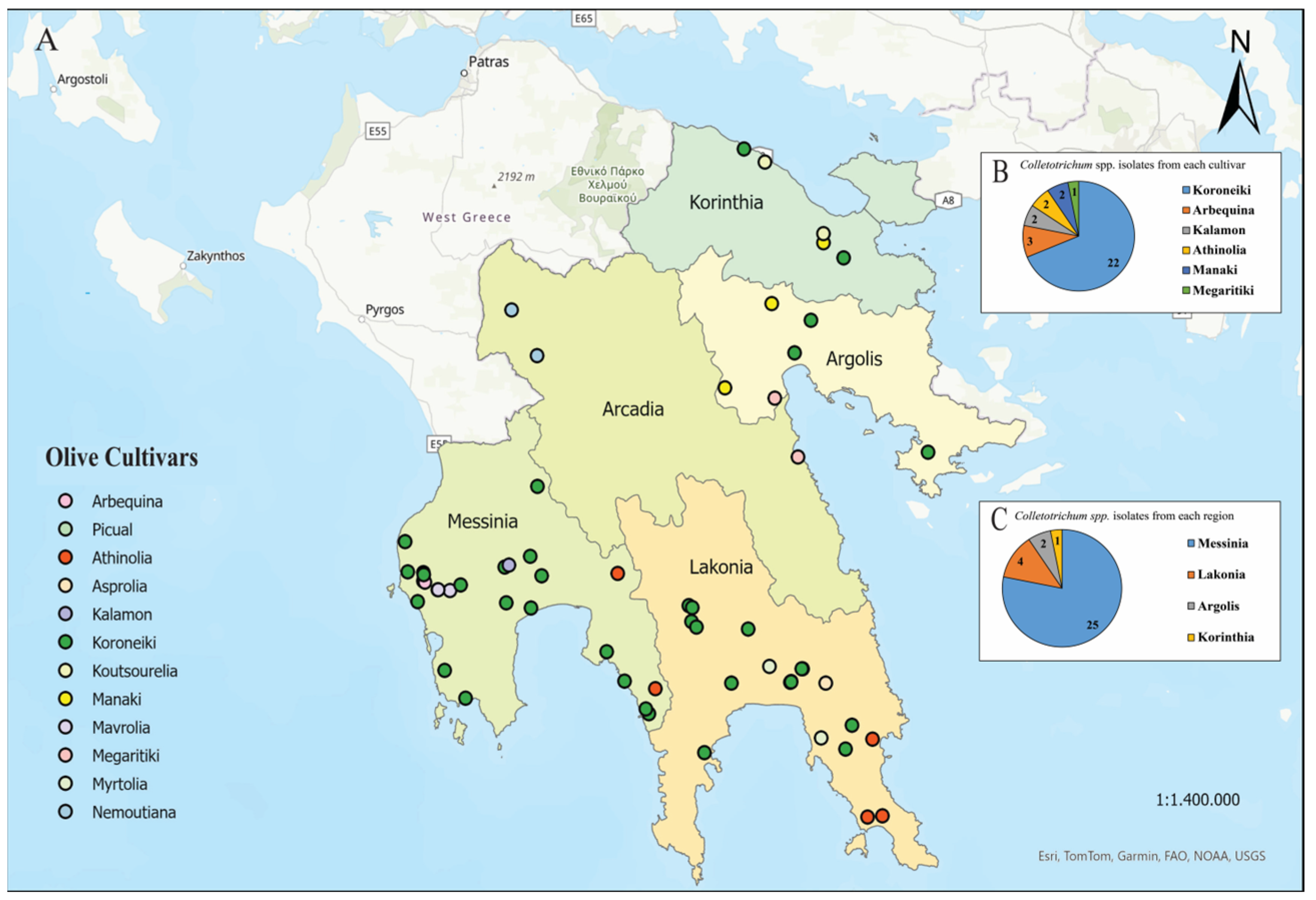
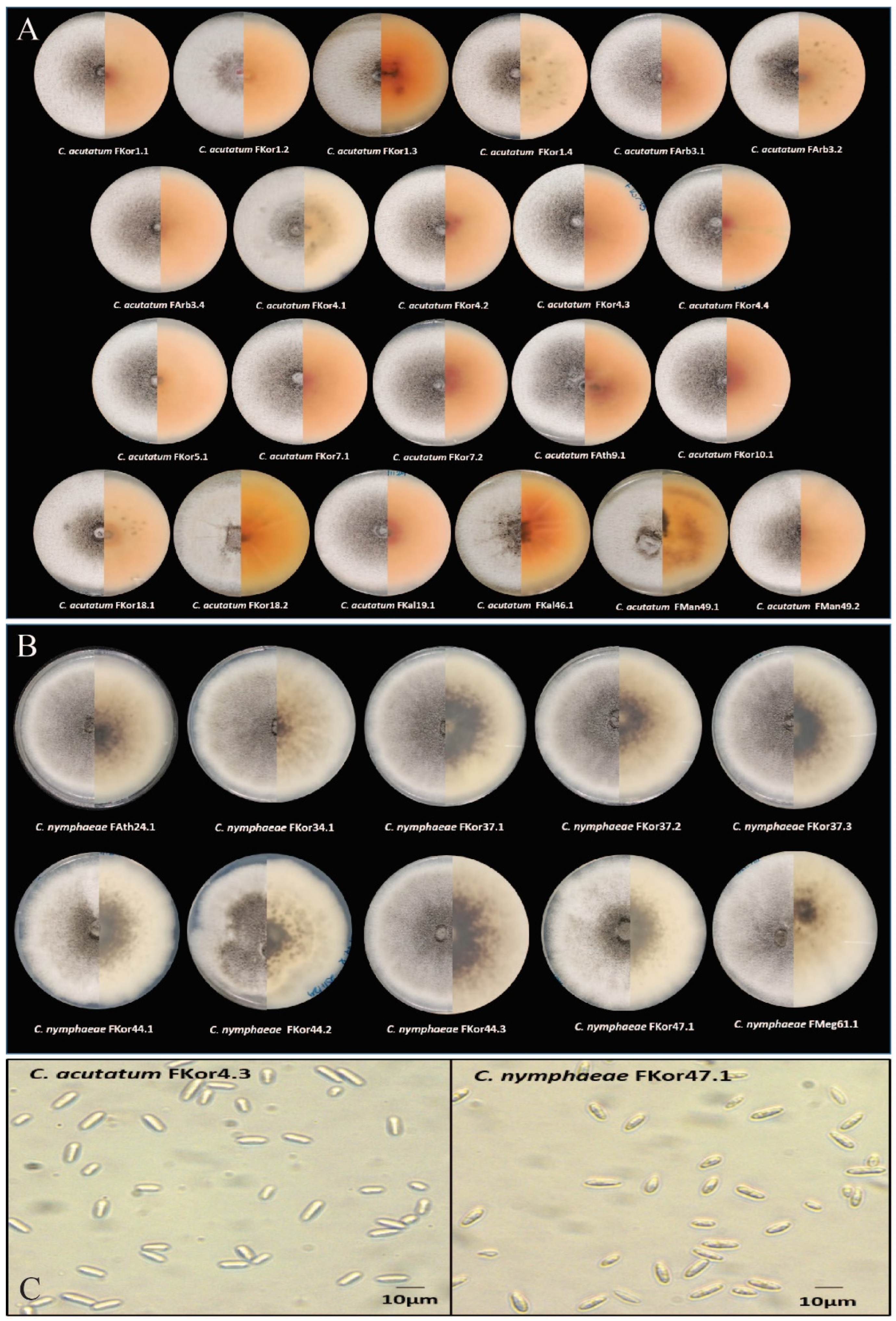
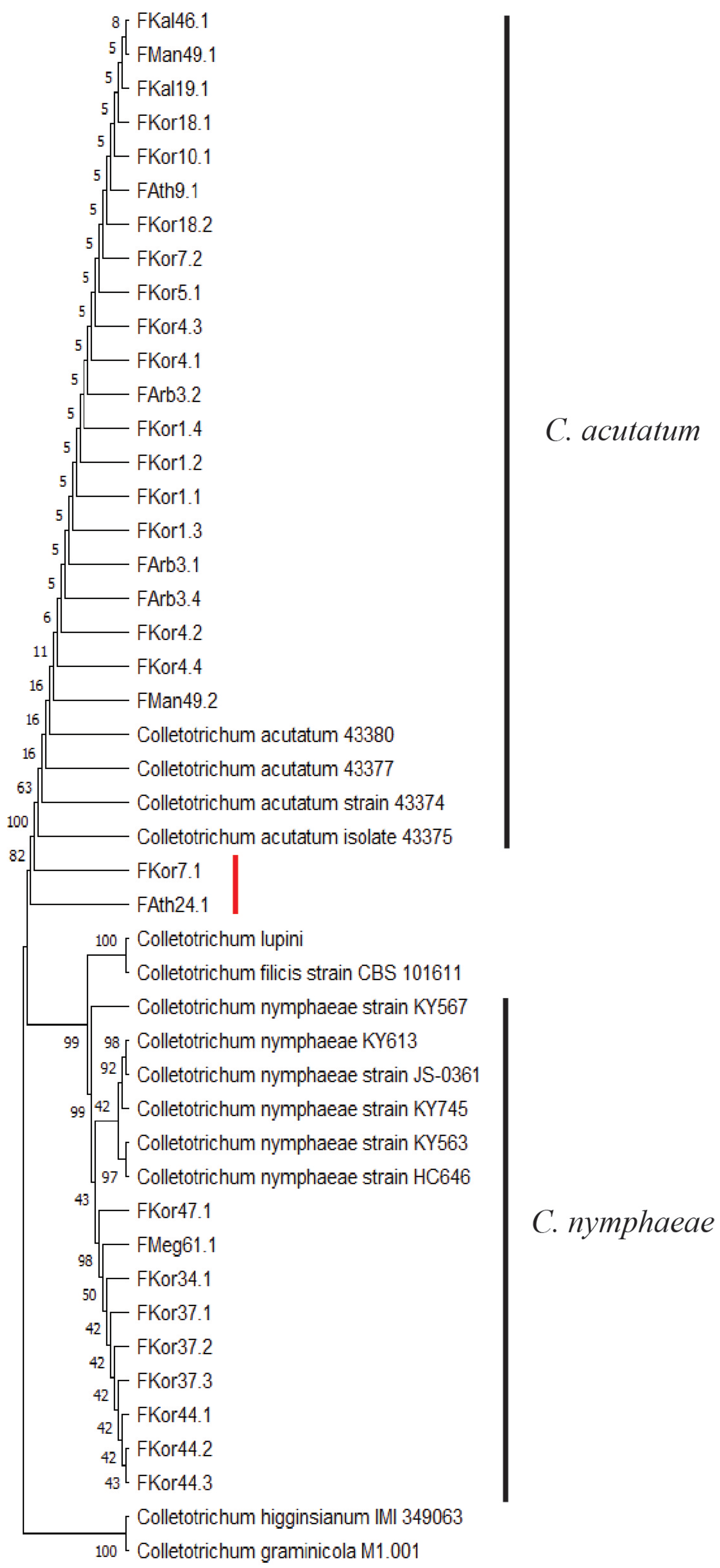
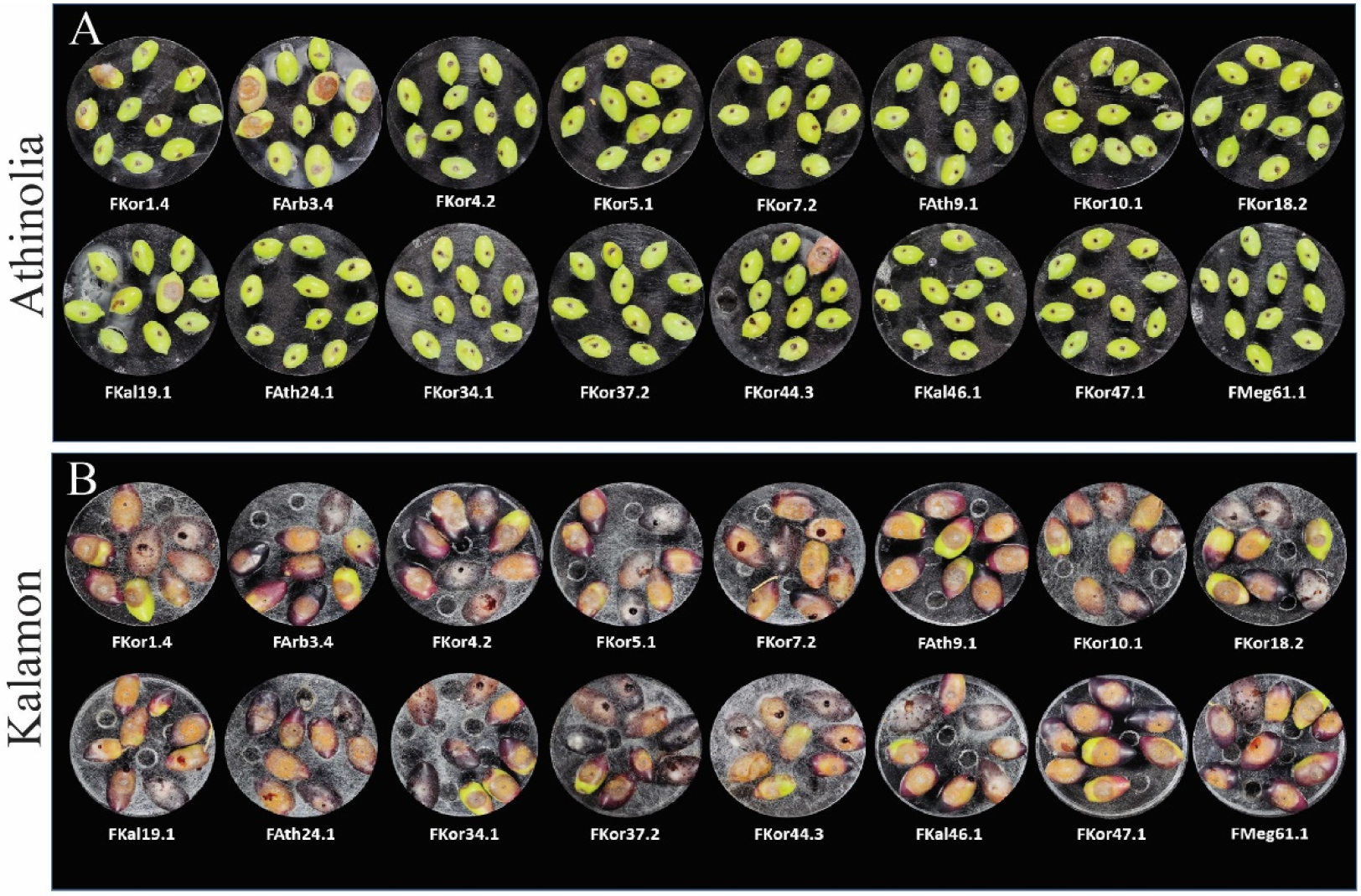
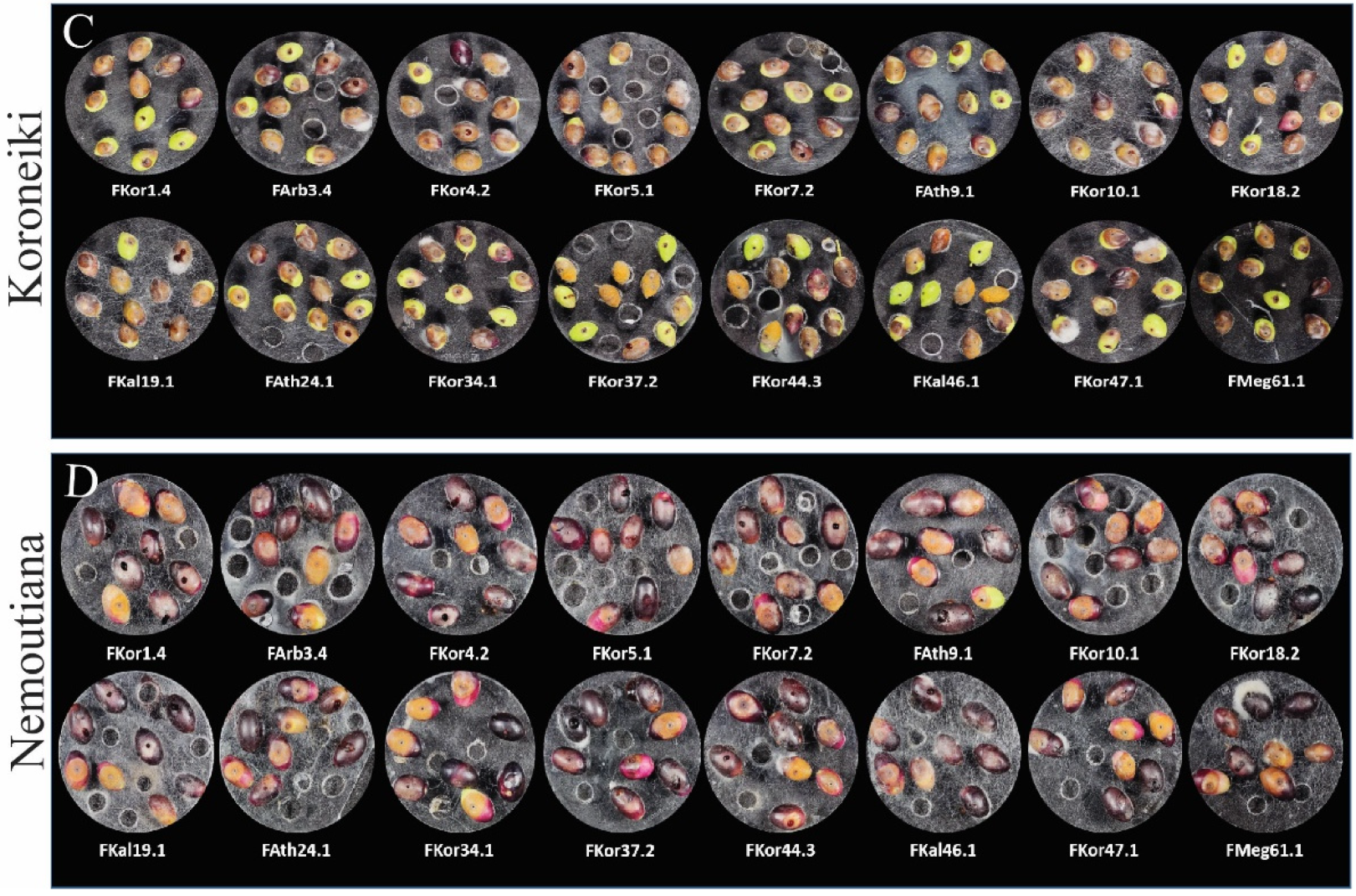


Disclaimer/Publisher’s Note: The statements, opinions and data contained in all publications are solely those of the individual author(s) and contributor(s) and not of MDPI and/or the editor(s). MDPI and/or the editor(s) disclaim responsibility for any injury to people or property resulting from any ideas, methods, instructions or products referred to in the content. |
© 2024 by the authors. Licensee MDPI, Basel, Switzerland. This article is an open access article distributed under the terms and conditions of the Creative Commons Attribution (CC BY) license (https://creativecommons.org/licenses/by/4.0/).
Share and Cite
Angeli, C.; Tsalgatidou, P.C.; Tsafouros, A.; Venieraki, A.; Zambounis, A.; Vithoulkas, A.; Milionis, A.; Paplomatas, E.J.; Demopoulos, V.; Delis, C. Genetic and Phytopathogenic Characterization of Endemic Colletotrichum Isolates in Major Olive Cultivars of Greece. Horticulturae 2024, 10, 847. https://doi.org/10.3390/horticulturae10080847
Angeli C, Tsalgatidou PC, Tsafouros A, Venieraki A, Zambounis A, Vithoulkas A, Milionis A, Paplomatas EJ, Demopoulos V, Delis C. Genetic and Phytopathogenic Characterization of Endemic Colletotrichum Isolates in Major Olive Cultivars of Greece. Horticulturae. 2024; 10(8):847. https://doi.org/10.3390/horticulturae10080847
Chicago/Turabian StyleAngeli, Christina, Polina C. Tsalgatidou, Athanasios Tsafouros, Anastasia Venieraki, Antonios Zambounis, Alexandros Vithoulkas, Anna Milionis, Epaminondas J. Paplomatas, Vasilios Demopoulos, and Costas Delis. 2024. "Genetic and Phytopathogenic Characterization of Endemic Colletotrichum Isolates in Major Olive Cultivars of Greece" Horticulturae 10, no. 8: 847. https://doi.org/10.3390/horticulturae10080847
APA StyleAngeli, C., Tsalgatidou, P. C., Tsafouros, A., Venieraki, A., Zambounis, A., Vithoulkas, A., Milionis, A., Paplomatas, E. J., Demopoulos, V., & Delis, C. (2024). Genetic and Phytopathogenic Characterization of Endemic Colletotrichum Isolates in Major Olive Cultivars of Greece. Horticulturae, 10(8), 847. https://doi.org/10.3390/horticulturae10080847










